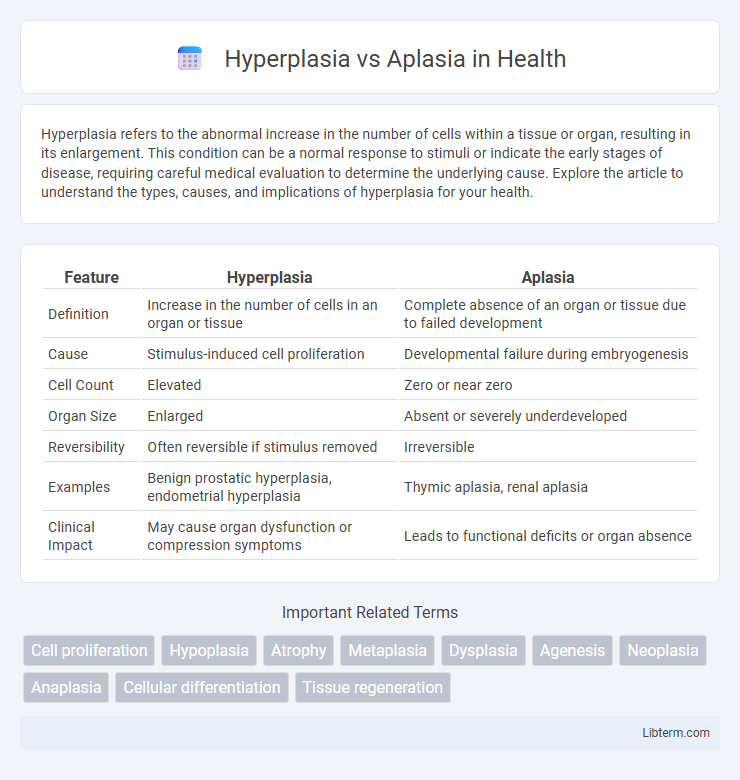Hyperplasia refers to the abnormal increase in the number of cells within a tissue or organ, resulting in its enlargement. This condition can be a normal response to stimuli or indicate the early stages of disease, requiring careful medical evaluation to determine the underlying cause. Explore the article to understand the types, causes, and implications of hyperplasia for your health.
Table of Comparison
| Feature | Hyperplasia | Aplasia |
|---|---|---|
| Definition | Increase in the number of cells in an organ or tissue | Complete absence of an organ or tissue due to failed development |
| Cause | Stimulus-induced cell proliferation | Developmental failure during embryogenesis |
| Cell Count | Elevated | Zero or near zero |
| Organ Size | Enlarged | Absent or severely underdeveloped |
| Reversibility | Often reversible if stimulus removed | Irreversible |
| Examples | Benign prostatic hyperplasia, endometrial hyperplasia | Thymic aplasia, renal aplasia |
| Clinical Impact | May cause organ dysfunction or compression symptoms | Leads to functional deficits or organ absence |
Understanding Hyperplasia and Aplasia
Hyperplasia refers to the increased production of cells within a tissue or organ, resulting in its enlargement due to a higher cell count, while aplasia denotes the complete absence or failure of development of an organ or tissue. Hyperplasia often occurs as a physiological response, such as in the proliferation of the endometrium during the menstrual cycle, whereas aplasia is typically congenital, exemplified by aplastic anemia where bone marrow cells fail to develop. Understanding hyperplasia involves recognizing its role in normal growth and healing, contrasting with aplasia, which signifies developmental defects or pathological absence.
Defining Hyperplasia: Causes and Mechanisms
Hyperplasia is the increase in the number of cells within a tissue or organ, resulting from enhanced cellular proliferation due to stimuli such as hormonal signals, chronic irritation, or growth factors. It occurs through mechanisms involving signal transduction pathways that promote cell cycle progression, leading to tissue enlargement while maintaining normal cellular architecture. Unlike aplasia, which is the complete absence of an organ or tissue due to developmental failure, hyperplasia represents an adaptive response often reversible upon removal of the causative stimuli.
Defining Aplasia: Causes and Mechanisms
Aplasia refers to the complete absence of an organ or tissue due to failure in its development during embryogenesis, often caused by genetic mutations, teratogenic agents, or vascular disruptions. This condition involves a lack of cell proliferation and differentiation necessary for organ formation, resulting in a permanent deficit from birth. In contrast, hyperplasia is characterized by an increase in cell number within an existing tissue due to stimuli such as hormonal signals or chronic injury, without developmental failure.
Key Differences Between Hyperplasia and Aplasia
Hyperplasia is characterized by an increase in the number of cells in a tissue or organ, leading to its enlargement, whereas aplasia refers to the complete absence or failure of an organ or tissue to develop. Hyperplasia is often a physiological or adaptive response to stimuli, such as hormonal signals or injury, while aplasia is typically a congenital defect resulting in missing structures. The key difference lies in hyperplasia representing cellular proliferation and growth, contrasted with aplasia indicating non-development or absence of cellular formation.
Clinical Manifestations of Hyperplasia
Hyperplasia presents clinically as an increase in the size of an organ or tissue due to an elevated number of cells, often manifesting as tissue enlargement or nodular formations. Common clinical manifestations include benign prostatic hyperplasia causing urinary obstruction, endometrial hyperplasia leading to abnormal uterine bleeding, and thyroid hyperplasia resulting in goiter. Unlike aplasia, which denotes the complete absence of an organ or tissue, hyperplasia is characterized by reversible cell proliferation in response to stimuli.
Clinical Manifestations of Aplasia
Aplasia presents clinically with severe symptoms such as pancytopenia, leading to fatigue, increased susceptibility to infections, and spontaneous bleeding due to the marked deficiency of all blood cell lineages. Patients often exhibit pallor, petechiae, and mucosal bleeding, accompanied by frequent infections from bacterial, viral, and fungal agents caused by neutropenia. Bone marrow biopsy in aplasia typically reveals a hypocellular or nearly acellular marrow, confirming the absence of hematopoietic activity.
Diagnostic Approaches: Hyperplasia vs Aplasia
Diagnostic approaches for hyperplasia often involve imaging techniques such as ultrasound, MRI, or mammography to detect tissue enlargement, complemented by biopsy to assess cellular proliferation and confirm abnormal growth patterns. In contrast, aplasia is typically diagnosed through congenital anomaly screening using prenatal ultrasound or MRI and genetic testing to identify absent or underdeveloped tissues, depending on the affected organ system. Histopathological examination remains essential in differentiating hyperplasia, characterized by increased cell number, from aplasia, which shows complete absence of tissue development.
Treatment Strategies for Hyperplasia
Treatment strategies for hyperplasia primarily involve addressing the underlying cause, such as hormonal imbalances or chronic irritation. Pharmacological interventions, including hormone therapy or anti-inflammatory medications, are commonly used to reduce abnormal cell proliferation. In some cases, surgical removal of the hyperplastic tissue may be necessary to prevent progression to malignancy.
Treatment Strategies for Aplasia
Treatment strategies for aplasia primarily involve supportive care such as blood transfusions and infection prevention due to the absence or failure of cell formation in tissues or organs. Bone marrow or stem cell transplantation is a key therapeutic approach to restore hematopoietic function in cases of aplastic anemia or severe aplasia. Immunosuppressive therapy may be utilized to manage aplasia caused by autoimmune conditions, improving hematopoiesis and patient outcomes.
Prognosis and Complications: Comparative Overview
Hyperplasia, characterized by an increase in cell number, generally has a favorable prognosis when the stimulus is removed, but can increase the risk of progression to neoplasia if uncontrolled. Aplasia, the complete absence of an organ or tissue, often results in significant functional impairment and higher risk of complications due to the lack of essential cellular components. Comparative prognosis highlights hyperplasia's potential reversibility versus aplasia's permanent structural deficit impacting overall health outcomes.
Hyperplasia Infographic

 libterm.com
libterm.com